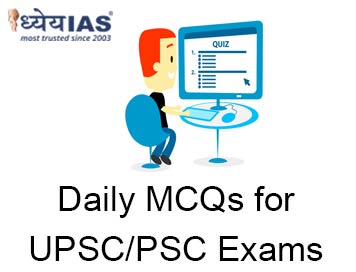Home > Daily-mcqs
Daily-mcqs 19 Nov 2025

Q1:
With reference to India’s forthcoming Revised Nationally Determined Contribution (NDC 3.0) for the 2031–2035 period, consider the following statements: 1. It is being formulated primarily to align India’s medium-term climate pathway with its commitment to achieve net-zero emissions by 2070. 2. The Revised NDC is likely to further scale up the renewable energy ambition by integrating the Green Hydrogen Mission and expanding nuclear energy. 3. Under the Paris Agreement, countries are required to submit their NDCs every five years to the UNFCCC Secretariat. How many of the above statements are correct?
A: Only one
B: Only two
C: All three
D: None
Answer: C
Explanation:
Statement 1 is correct.
The revised NDC (2031–2035) is explicitly designed as an intermediate milestone toward India’s net-zero by 2070 goal, ensuring alignment of mitigation pathways and sectoral transitions.
Statement 2 is correct.
NDC 3.0 is expected to scale mitigation ambition, including increased renewable energy deployment, integration of the Green Hydrogen Mission, expansion of nuclear power, and push for electric mobility.
Statement 3 is correct.
Under the Paris Agreement, countries must submit updated or new NDCs every five years to the UNFCCC Secretariat as part of the global stocktake cycle.
Q2:
With reference to India’s Updated Nationally Determined Contribution (NDC), 2022, consider the following statements: 1. India has committed to reducing the emissions intensity of its GDP by 45% from 2005 levels by 2030. 2. India aims to achieve 50% of cumulative installed electric power capacity from non-fossil fuel sources by 2030. 3. India has carbon sink target to 4–5 billion tonnes of CO₂ equivalent through afforestation by 2030. How many of the above statements are correct?
A: Only one
B: Only two
C: all three
D: None
Answer: B
Explanation:
Statement 1 is correct.
The 2022 updated NDC commits to a 45% reduction in emissions intensity of GDP by 2030 relative to 2005 levels.
Statement 2 is correct.
India’s updated NDC includes the target of achieving 50% installed power capacity from non-fossil fuel sources by 2030.
Statement 3 is incorrect.
The carbon sink target remains 2.5–3 billion tonnes CO₂-equivalent, not 4–5 billion tonnes.
Q3:
With reference to the Sentinel-6B satellite, consider the following statements: 1. It is part of the Copernicus Sentinel-6/Jason-CS mission. 2. Its primary instrument, Poseidon-4 radar altimeter, measures sea surface height with centimeter-level accuracy. 3. Sentinel-6B’s GNSS Radio Occultation (GNSS-RO) instrument is used only for tracking satellite navigation signals. How many of the above statements are correct?
A: Only one
B: Only two
C: All three
D: None
Answer: B
Explanation:
Statement 1 is correct.
Sentinel-6B is part of the Copernicus Sentinel-6/Jason-CS mission, a collaboration between ESA, NASA, NOAA, EUMETSAT, and CNES.
Statement 2 is correct.
The Poseidon-4 radar altimeter provides centimeter-level precise measurements of sea surface height, crucial for tracking global sea-level rise.
Statement 3 is incorrect.
The GNSS-RO instrument does provide vertical atmospheric profiles of temperature and humidity, aiding weather and climate models. It is not limited to navigation; it is a key atmospheric research tool.
Q4:
With reference to the first-ever detection of a coronal mass ejection (CME) on another star, consider the following statements: 1. The CME was detected on StKM 1–1262, a red dwarf located about 133 light-years away. 2. It's CME was approximately 10,000 times more powerful than typical solar CMEs emitted by the Sun. 3. Red dwarfs usually have weaker magnetic fields than the Sun, which makes massive CMEs extremely rare on them. How many of the statements given above are correct?
A: Only one
B: Only two
C: All three
D: None
Answer: B
Explanation:
Statement 1 is correct.
The coronal mass ejection (CME) was detected on the red dwarf StKM 1–1262, located 133 light-years away. It is the first such discovery outside our Solar System.
Statement 2 is correct.
The stellar CME was estimated to be 10,000 times more intense than a typical CME from the Sun.
Statement 3 is incorrect.
Red dwarfs often have much stronger magnetic fields — up to 300× stronger than the Sun.
This strong magnetism makes massive and frequent CMEs more likely, not rare.
Q5:
Consider the following statements regarding the Mahatma Gandhi National Rural Employment Guarantee Scheme (MGNREGS): 1. It legally guarantees at least 100 days of wage employment per year to every rural household. 2. Workers are entitled to unemployment allowance if work is not provided within 15 days of demanding employment. 3. MGNREGS is a supply-driven programme. Which of the statements given above is/are correct?
A: 1 and 2 only
B: 1 and 3 only
C: 2 and 3 only
D: 1, 2, and 3
Answer: A
Explanation:
Statement 1 is correct.
Under the MGNREGA Act, 2005, every rural household is legally guaranteed at least 100 days of wage employment each year.
Statement 2 is correct.
If employment is not provided within 15 days of a worker demanding work, he/she is entitled to an unemployment allowance, making the scheme rights-based.
Statement 3 is incorrect.
MGNREGS is demand-driven, not supply-driven